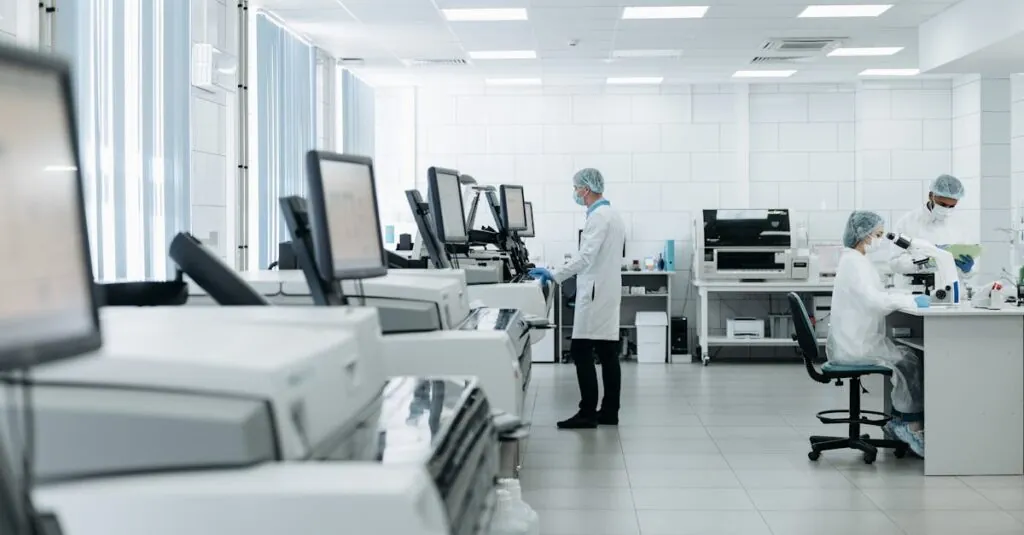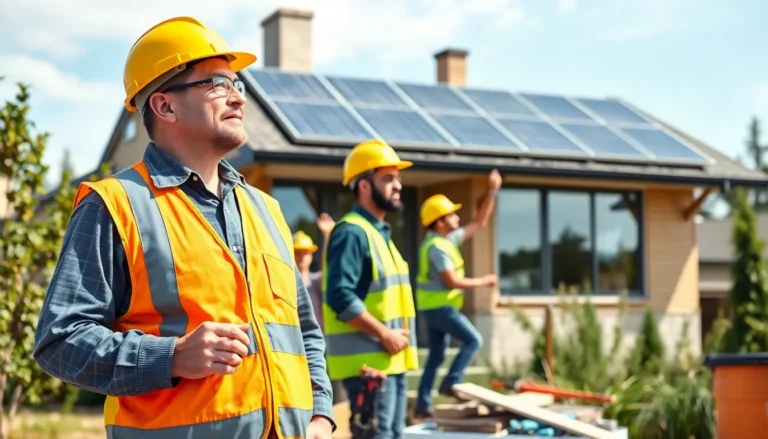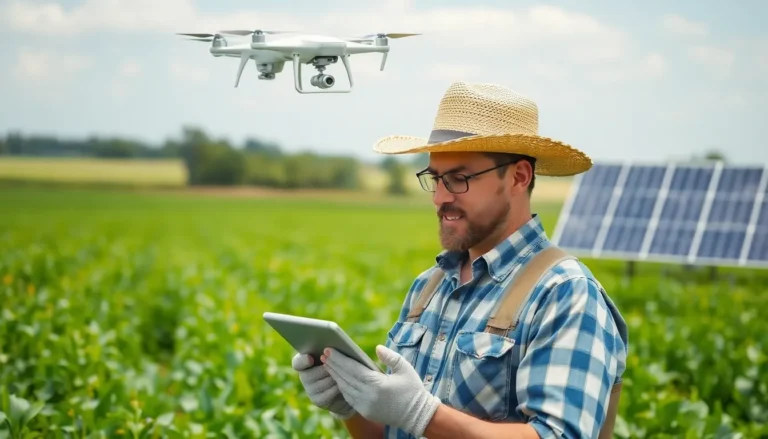Table of Contents
ToggleSanitation might not be the most glamorous topic, but let’s face it—everyone appreciates a clean bathroom. As the world grapples with growing populations and environmental challenges, sanitation innovation steps in like a superhero with a plunger. These groundbreaking solutions are not just about keeping things tidy; they’re about transforming lives and protecting our planet.
Overview Of Sanitation Innovation
Sanitation innovation plays a vital role in enhancing public health and environmental sustainability. Innovative technologies and approaches tackle problems associated with waste management, clean water access, and hygiene practices. Solutions like waterless toilets, smart sewage systems, and waste-to-energy models exemplify the potential for change.
Transformative designs for sanitation facilities focus on user experience and ecological impact. For example, modular toilets adapt to various environments, ensuring effective waste management in urban and rural settings. Smart monitoring systems optimize water usage by detecting leaks and minimizing waste.
Various organizations and startups drive advancements in sanitation. Notable entities include organizations like the Bill & Melinda Gates Foundation, which funds research and development for affordable sanitation technologies. Additionally, companies like Paean strive for innovative toilet designs that function without traditional plumbing systems.
Emerging market needs shape the focus of sanitation innovation. Countries with limited infrastructure can benefit significantly from low-cost, efficient sanitation solutions. By implementing these technologies, communities can improve health outcomes and reduce environmental degradation.
Data-driven insights support sanitation efforts. According to the World Health Organization, improvements in sanitation can reduce disease prevalence by up to 30%. This statistic underscores the urgency of investing in sanitation innovation, highlighting its role in fostering healthier communities and protecting ecosystems.
Overall, sanitation innovation paves the way for safer, cleaner living environments. As new technologies emerge, the potential for widespread adoption increases, offering hope for populations facing sanitation challenges.
Importance Of Sanitation Innovation
Sanitation innovation plays a key role in promoting public health and environmental sustainability. Advancements in this sector address issues faced by growing populations and deteriorating ecosystems.
Health Benefits
Innovative sanitation solutions significantly improve health outcomes. Studies from the World Health Organization show improved sanitation can reduce disease prevalence by up to 30%. Access to clean water, improved hygiene practices, and effective waste management leads to lower rates of waterborne diseases. Communities benefit from reduced healthcare costs and increased productivity. Enhanced sanitation infrastructures, such as waterless toilets and smart sewage systems, provide safer living conditions, thus simplifying hygiene for everyone.
Environmental Impact
Innovative sanitation greatly impacts environmental health. Transformative designs help manage waste more effectively while conserving water. Modular toilets and waste-to-energy systems contribute to reduced landfill use and decreased pollution. These innovations tackle water scarcity issues, promoting sustainable practices that benefit ecosystems. Clean environments lead to healthier habitats for humans and wildlife alike. With effective waste management systems, communities work toward a greener future, ensuring longevity for natural resources.
Key Technologies In Sanitation Innovation
Sanitation innovation leverages advanced technologies to enhance public health and environmental sustainability. Various technologies lead the way in transforming sanitation practices.
Smart Toilets
Smart toilets utilize sensors and connectivity features to optimize water usage and enhance user experience. These toilets can monitor water levels, detect blockages, and provide real-time data for maintenance. Innovation in user interface design contributes to better hygiene practices, ensuring a cleaner environment. The integration of smart toilets in urban areas can significantly decrease water waste while improving sanitation efficiency. Data supports that implementing smart systems leads to reduced operational costs, promoting healthier communities.
Waste-to-Energy Systems
Waste-to-energy systems convert organic waste into renewable energy sources. By processing waste efficiently, these systems reduce landfill dependency and mitigate greenhouse gas emissions. Energy recovery from waste can power local infrastructures or contribute to the energy grid, especially in areas with limited resources. Specific models, like anaerobic digesters, enhance microbial processes to break down waste effectively. Studies indicate that such systems can minimize waste disposal costs while providing sustainable energy solutions for communities.
Mobile Sanitation Solutions
Mobile sanitation solutions address sanitation challenges in underserved regions through portable toilets and hygiene units. These units offer immediate access to sanitation during emergencies or large events, promoting public health. Accessibility to handwashing stations enhances hygiene practices, reducing disease transmission. Operators can easily transport these solutions to areas lacking infrastructure, providing crucial support in remote locations. Research shows that mobile sanitation options significantly improve overall hygiene standards and foster a healthier community environment.
Challenges Facing Sanitation Innovation
Sanitation innovation encounters significant barriers that hinder progress. These include funding challenges and public acceptance issues, both of which need to be addressed for effective implementation.
Funding And Investment
Funding remains a primary hurdle for sanitation innovation. Many projects lack financial backing, limiting their expansion in underserved regions. Organizations like the Bill & Melinda Gates Foundation play crucial roles by providing grants for innovative solutions. Investments in sustainable sanitation can yield long-term health benefits, with the World Health Organization reporting up to 30% reductions in disease prevalence. Public-private partnerships can also enhance resources, driving technological advancements. Competing priorities often divert attention from sanitation, emphasizing the need for targeted funding initiatives.
Public Acceptance
Public acceptance significantly influences the success of sanitation innovations. Communities often resist new technologies due to cultural beliefs and unfamiliarity. User-friendly designs can help ease apprehensions and promote adoption. Education campaigns that raise awareness about health benefits are vital in fostering acceptance. Stakeholder engagement is critical; involving community members in the innovation process can help address concerns and tailor solutions. Effective communication of the advantages of improved sanitation leads to increased willingness to embrace change.
Future Trends In Sanitation Innovation
Emerging technologies are shaping the future of sanitation innovation. Smart toilets equipped with sensors optimize water usage while enhancing the user experience. These advancements cater to individual needs and improve overall sanitation efficiency.
Waste-to-energy systems play a pivotal role in converting organic waste into renewable energy. Organizations harness these systems to address waste management challenges while promoting sustainability. Converted waste reduces landfill reliance and generates clean energy.
Mobile sanitation solutions offer flexibility in providing hygiene units to underserved regions. Portable restrooms enhance sanitation access for communities lacking infrastructure. Deploying these units helps ensure that even remote populations maintain hygiene standards.
Data-driven insights guide sanitation innovation, with organizations utilizing analytics to improve designs. Advanced monitoring systems manage waste effectively and track water usage. Improved sanitation access can reduce disease prevalence by up to 30%, showcasing the critical impact of these innovations.
Investment in sanitation continues to grow, supported by entities like the Bill & Melinda Gates Foundation. Grants provided by such organizations drive projects in areas lacking resources. Financial backing remains essential for the expansion and improvement of sanitation technologies.
Public acceptance significantly influences the success of sanitation innovations. Communities must embrace new technologies for enhancements to take root. Educating residents about the benefits and practicality of these solutions is crucial for fostering adoption.
Transformative designs prioritize ecological impact while focusing on user experience. Modular toilets, for instance, adapt to various environments and respond to local needs. Innovations in sanitation not only enhance public health but also contribute to building cleaner, healthier communities.
Conclusion
Sanitation innovation is reshaping the way communities approach hygiene and waste management. By integrating advanced technologies and sustainable practices, these innovations offer practical solutions to pressing global challenges. The focus on user experience and ecological impact ensures that sanitation systems not only meet immediate needs but also contribute to long-term health and environmental goals.
As organizations and startups continue to push the boundaries of what’s possible, the potential for positive change becomes increasingly evident. Investing in these transformative solutions is essential for creating cleaner, healthier living environments. Embracing sanitation innovation will ultimately lead to improved public health outcomes and a more sustainable future for all.







